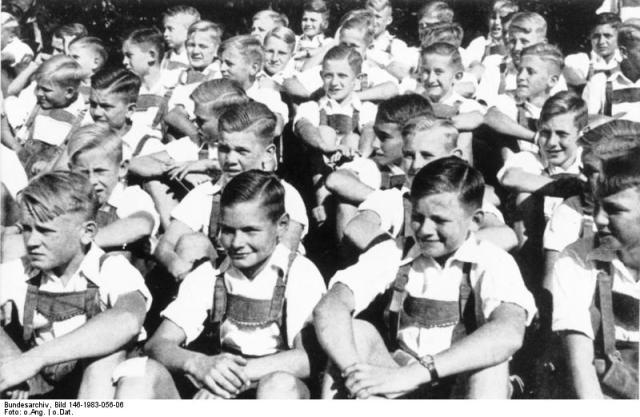Anti-Semitism and the holocaust are among the central themes in the modern German secondary school curriculum. During history lessons in middle school, we learned about anti-Semitism and the persecution of Jews in Europe during the middle ages and early modernity. Our history curriculum in the ninth and tenth grades focused on the virulent growth of anti-Semitism in 20th century Europe, how Hitler and the Nazi party used anti-Semitism as a means to rally support and gain power, and how the Nazi apparatus implemented the systematic genocide of millions of Jews.

In grades 11 to 13, the educational focus shifts to a discussion of the broader moral and political context of anti-Semitism and Nazism. How could the Nazis enlist the active and passive help of millions of “upstanding” citizens to participate in this devastating genocide? Were all Germans who did not actively resist the Nazis morally culpable or at least morally responsible for the Nazi horrors? Did Germans born after the Second World War inherit some degree of moral responsibility for the crimes committed by the Nazis? How can German society ever redeem itself after being party to the atrocities of the Nazis? Anti-Semitism and Nazism were also important topics in our German literature and art classes because the Nazis persecuted and murdered German Jewish intellectuals and artists, and because the shame and guilt experienced by Germans after 1945 featured so prominently in German art and literature.
One purpose of extensively educating Germany school-children about this dark and shameful period of German history is the hope that if they are ever faced with the reemergence of prejudice directed against Jews or any other ethnic or religious group, they will have the courage to stand up for those who are being persecuted and make the right moral choices. As such, it is part of the broader Vergangenheitsbewältigung (wrestling with one’s past) in post-war German society which takes place not only in schools but in various public venues. The good news, according to recent research published in the Proceedings of the National Academy of Sciences by Nico Voigtländer and Hans-Joachim Voth, is that Germans who attended school after the Second World War have shown a steady decline in anti-Semitism. The bad news: Vergangenheitsbewältigung is a bigger challenge for Germans who attended school under the Nazis because a significant proportion of them continue to exhibit high levels of anti-Semitic attitudes more than half a century after the defeat of Nazi Germany.
Voigtländer and Voth examined the results of the large General Social Survey for Germany (ALLBUS) in which several thousand Germans were asked about their values and beliefs. The survey took place in 1996 and 2006, and the researchers combined the results of both surveys with a total of 5,300 participants from 264 German towns and cities. The researchers were specifically interested in anti-Semitic attitudes and focused on three survey questions specifically related to anti-Semitism. Survey participants were asked to respond on a scale of 1 to 7 and indicate whether they thought Jews had too much influence in the world, whether Jews were responsible for their own persecution and whether Jews should have equal rights. The researchers categorized participants as “committed anti-Semites” if they revealed anti-Semitic attitudes to all three questions. The overall rate of committed anti-Semites was 4% in Germany but there was significant variation depending on the geographical region and the age of the participants.
Germans born in the 1970s and 1980s had only 2%-3% committed anti-Semites whereas the rate was nearly double for Germans born in the 1920s (6%). However, the researchers noted one exception: Germans born in the 1930s. Those citizens had the highest fraction of anti-Semites: 10%. The surveys were conducted in 1996 and 2006 when the participants born in in the 1930s were 60-75 years old. In other words, one out of ten Germans of that generation did not think that Jews deserved equal rights!
The researchers attributed this to the fact that people born in the 1930s were exposed to the full force of systematic Nazi indoctrination with anti-Semitic views which started as early as in elementary school and also took place during extracurricular activities such as the Hitler Youth programs. The Nazis came to power in 1933 and immediately began implementing a whole-scale propaganda program in all schools. A child born in 1932, for example, would have attended elementary school and middle school as well as Hitler Youth programs from age six onwards till the end of the war in 1945 and become inculcated with anti-Semitic propaganda.
The researchers also found that the large geographic variation in anti-Semitic prejudices today was in part due to the pre-Nazi history of anti-Semitism in any given town. The Nazis were not the only and not the first openly anti-Semitic political movement in Germany. There were German political parties with primarily anti-Jewish agendas which ran for election in the late 19th century and early 20th century. Voigtländer and Voth analyzed the votes that these anti-Semitic parties received more than a century ago, from 1890 to 1912. Towns and cities with the highest support for anti-Semitic parties in this pre-Nazi era are also the ones with the highest levels of anti-Semitic prejudice today. When children were exposed to anti-Semitic indoctrination in schools under the Nazis, the success of these hateful messages depended on how “fertile” the ground was. If the children were growing up in towns and cities where family members or public figures had supported anti-Jewish agenda during prior decades then there was a much greater likelihood that the children would internalize the Nazi propaganda. The researchers cite the memoir of the former Hitler Youth member Alfons Heck:
“We who were born into Nazism never had a chance unless our parents were brave enough to resist the tide and transmit their opposition to their children. There were few of those.”
– Alfons Heck in “The Burden of Hitler’s Legacy“
The researchers then address the puzzling low levels of anti-Semitic prejudices among Germans born in the 1920s. If the theory of the researcher were correct that anti-Semitic prejudices persist today because Nazi school indoctrination then why aren’t Germans born in the 1920s more anti-Semitic? A child born in 1925 would have been exposed to Nazi propaganda throughout secondary school. Oddly enough, women born in the 1920s did show high levels of anti-Semitism when surveyed in 1996 and 2006 but men did not. Voigtländer and Voth solve this mystery by reviewing wartime fatality rates. The most zealous male Nazi supporters with strong anti-Semitic prejudices were more likely to volunteer for the Waffen-SS, the military wing of the Nazi party. Some SS divisions had an average age of 18 and these SS-divisions had some of the highest fatality rates. This means that German men born in the 1920s weren’t somehow immune to Nazi propaganda. Instead, most of them perished because they bought into it and this is why we now see lower levels of anti-Semitism than expected in Germans born during that decade.
A major limitation of this study is its correlational nature and the lack of data on individual exposure to Nazism. The researchers base their conclusions on birth years and historical votes for anti-Semitic parties of towns but did not track how much individuals were exposed to anti-Semitic propaganda in their schools or their families. Such a correlational study cannot establish a cause-effect relationship between propaganda and the persistence of prejudice today. One factor not considered by the researchers, for example, is that Germans born in the 1930s are also among those who grew up as children in post-war Germany, often under conditions of extreme poverty and even starvation.
Even without being able to establish a clear cause-effect relationship, the findings of the study raise important questions about the long-term effects of racial propaganda. It appears that a decade of indoctrination may give rise to a lifetime of hatred. Our world continues to be plagued by prejudice against fellow humans based on their race or ethnicity, religion, political views, gender or sexual orientation. Children today are not subject to the systematic indoctrination implemented by the Nazis but they are probably still exposed to more subtle forms of prejudice and we do not know much about its long-term effects. We need to recognize the important role of public education in shaping the moral character of individuals and ensure that our schools help our children become critical thinkers with intact moral reasoning, citizens who can resist indoctrination and prejudice.
Reference:
Voigtländer N and Voth HJ. “Nazi indoctrination and anti-Semitic beliefs in Germany” Proceedings of the National Academy of Sciences (2015), doi: 10.1073/pnas.1414822112
![]()
Voigtländer N, & Voth HJ (2015). Nazi indoctrination and anti-Semitic beliefs in Germany. Proceedings of the National Academy of Sciences of the United States of America PMID: 26080394
Note: An earlier version of this article was first published on the 3Quarksdaily Blog.






